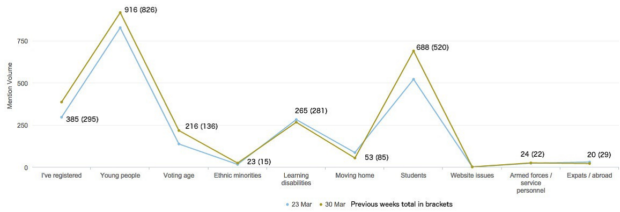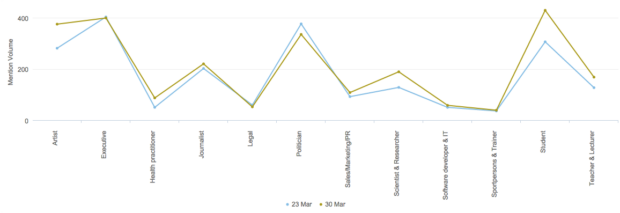Last week we blogged about our use of online monitoring tools; how we’ve been working with other government departments to support campaign monitoring and evaluation, and helping them build their own expertise in this area.
The last few months have been busy. Most recently, we’ve been supporting the Individual Electoral Registration (IER) team, part of Cabinet Office, in understanding how users have been engaging with the new, digital www.gov.uk/register-to-vote service. What were people's thoughts on the registration process? Could there be important user feedback that would help make improvements? Finally, how could these insights inform wider campaigns, reminding people to register?
We invited Jamie Burton, Communications Manager for the IER Service to share his experiences of using an online monitoring tool; the real-time insights he discovered, and the impact these had on the wider IER delivery programme.
Monitoring campaigns in real-time: Individual Electoral Registration
Jamie Burton, Communications Manager, IER Service Cabinet Office
In 2014 the Government introduced Individual Electoral Registration (IER) and the www.gov.uk/register-to-vote service to enable online registration for the first time.
We wanted to know what members of the public registering to vote thought about the new service. To do this we needed an online monitoring and analysis tool which could provide us real-time insight into people’s thoughts about the biggest transformation to electoral registration in a century.
By using a digital monitoring tool, Brandwatch, we were able to react rapidly to feedback from users online, whether it was a blog about the web service with some things for us to focus on when considering future development work, or tweets that suggested to us where users were having difficulties completing applications.
Responding to user feedback
Brandwatch’s impact score gave us the opportunity to highlight particularly significant user feedback. We adjusted content on www.gov.uk/register-to-vote when it became obvious that certain messages could be made clearer for service users. For example, we tailored the language to encourage applicants to provide as much information as possible upfront, making it clear that this would minimise processing times. We used the insight gathered from online conversations about the service to consider what onsite messages would be more effective.
Working with GDS and building capability
GDS colleagues’ knowledge and desire to collaborate has been energising. Chris Watson gave me an excellent introduction to Brandwatch and showed me the doors that tools like this can open for government communicators. I built queries (to define what content we were looking for) and dashboards (to represent the data) following his guidance.
Chris augmented what I had built into one comprehensive query and super-dashboard which we could then segment, filter and customise to produce detailed weekly reports and analysis. These gave us an in-depth view of all the online activity we were interested in and provided us with important demographic insights, trend analysis and granular detail about where and when important issues were being raised online.
Focusing on user needs
Public confidence in electoral registration has been of great importance throughout the transition. Evidence from the data enabled us to focus our work on our users’ needs, advise our partners about what might enable target groups to access the service more easily and increase the visibility of the service to those less engaged.
There is no doubt that use of the tool helped us make history during the transition to IER, with more people registering to vote than ever before. Armed with this rich data, we were able to shape the new service in response to what we were hearing from users.
Sharing best practice
This project attracted lots of interest. These tools are empowering, not just for communications professionals, but for policy experts considering public interest in new proposals; for legislation experts evaluating how new regulations are being perceived; for finance experts considering how resources can best be focused – there is no exhaustive list.
I gave demonstrations to colleagues with wide-ranging professional interests. The government is sometimes accused of being reluctant to adopt digital solutions – the results of this project show that at the Cabinet Office we are hungry for innovative digital approaches.
Online monitoring tools on the market can be hugely beneficial in enabling targeted and spontaneous communications agility, and informing and shaping conversations alongside rapidly evolving agendas. Most importantly, these tools allow government officials to gain an insight into their primary audience – the public.



3 comments
Comment by Mitul posted on
Hi Georgina, this is a really interesting topic. I'd be interested to get your thoughts on listening to the public's experiences as they are having them on the GDS website. As good as it is listening and being aware of their thoughts from social media, do you think it would also be useful to hear their feedback from their experiences on the actual website?
Comment by Georgina Goode posted on
Hi there,
Register to Vote is an example of this as we were listening to how users interacted with the service and then we took their feedback to make improvements on GOV.UK. In fact we receive lots of feedback from users about various parts of GOV.UK which we then pass on to departments. We also have links on all GOV.UK pages which allow users to feedback their experiences, plus do ongoing user research/testing to make sure that what we're doing is meeting user needs.
Many Thanks
Georgina
Comment by simonfj posted on
".. we receive lots of feedback from users about various parts of GOV.UK which we then pass on to departments".
That's an interesting comment Georgina, especially because of that link at the bottom of every page. i.e. "Is there anything wrong with this page?" But isn't that the problem, and opportunity? Feedback is directed to a department below the radar, whereas what we do need is a way to direct users to a particular service design/maintenance group, which will span across depts. https://www.gov.uk/service-manual/the-team
This link at the bottom of most gov.uk pages is a terrific opportunity to bring the users of a individual service, and its designers, to a forum where they could share, and keep, a learning/co-design about a specific topic or service.
It could also act as a place to FAQs about a particular topic or service. As you say, we have all this really useful info about users that could be used in all sorts of ways. But because there is no ongoing engagement/outreach (to be seen) between users and design teams, we never get to develop the kind of open co-design culture which will have teams in different govs, and their departments, working with their users (and private co-designers) to continuously improve their products.
E.g. We know that people move house quite often, so the local IERs will always need to be updated. http://www.independent.co.uk/property/how-often-do-people-move-house-8969393.html Question is, who will inform the National databases/services ONCE that a voter has a new address?
These kind of insights are not hard to imagine, once we get different (local and central) perspectives focussing, and engaging, on the same service together. All the best.